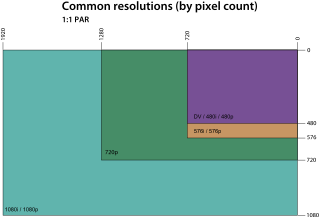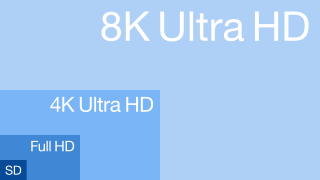
A computer monitor is an output device that displays information in pictorial or textual form. A discrete monitor comprises a visual display, support electronics, power supply, housing, electrical connectors, and external user controls.

A liquid-crystal display (LCD) is a flat-panel display or other electronically modulated optical device that uses the light-modulating properties of liquid crystals combined with polarizers. Liquid crystals do not emit light directly but instead use a backlight or reflector to produce images in color or monochrome.

In digital imaging, a pixel, pel, or picture element is the smallest addressable element in a raster image, or the smallest addressable element in a dot matrix display device. In most digital display devices, pixels are the smallest element that can be manipulated through software.

Standard-definition television is a television system that uses a resolution that is not considered to be either high or enhanced definition. Standard refers to offering a similar resolution to the analog broadcast systems used when it was introduced.

The Enhanced Graphics Adapter (EGA) is an IBM PC graphics adapter and de facto computer display standard from 1984 that superseded the CGA standard introduced with the original IBM PC, and was itself superseded by the VGA standard in 1987. In addition to the original EGA card manufactured by IBM, many compatible third-party cards were manufactured, and EGA graphics modes continued to be supported by VGA and later standards.
Anamorphic widescreen is a process by which a comparatively wide widescreen image is horizontally compressed to fit into a storage medium with a narrower aspect ratio, reducing the horizontal resolution of the image while keeping its full original vertical resolution. Compatible play-back equipment can then expand the horizontal dimension to show the original widescreen image. This is typically used to allow one to store widescreen images on a medium that was originally intended for a narrower ratio, while using as much of the frame – and therefore recording as much detail – as possible.

The display resolution or display modes of a digital television, computer monitor or display device is the number of distinct pixels in each dimension that can be displayed. It can be an ambiguous term especially as the displayed resolution is controlled by different factors in cathode ray tube (CRT) displays, flat-panel displays and projection displays using fixed picture-element (pixel) arrays.

1080p is a set of HDTV high-definition video modes characterized by 1,920 pixels displayed across the screen horizontally and 1,080 pixels down the screen vertically; the p stands for progressive scan, i.e. non-interlaced. The term usually assumes a widescreen aspect ratio of 16:9, implying a resolution of 2.1 megapixels. It is often marketed as Full HD or FHD, to contrast 1080p with 720p resolution screens. Although 1080p is sometimes referred to as 2K resolution, other sources differentiate between 1080p and (true) 2K resolution.

Fixed pixel displays are display technologies such as LCD and plasma that use an unfluctuating matrix of pixels with a set number of pixels in each row and column. With such displays, adjusting (scaling) to different aspect ratios because of different input signals requires complex processing.

The native resolution of an liquid crystal display (LCD), liquid crystal on silicon (LCoS) or other flat panel display refers to its single fixed resolution. As an LCD consists of a fixed raster, it cannot change resolution to match the signal being displayed as a cathode-ray tube (CRT) monitor can, meaning that optimal display quality can be reached only when the signal input matches the native resolution. An image where the number of pixels is the same as in the image source and where the pixels are perfectly aligned to the pixels in the source is said to be pixel perfect.
1440p is a family of video display resolutions that have a vertical resolution of 1440 pixels. The p stands for progressive scan, i.e. non-interlaced. The 1440 pixel vertical resolution is double the vertical resolution of 720p, and one-third more than 1080p. QHD or WQHD is the designation for a commonly used display resolution of 2560 × 1440 pixels in a 16:9 aspect ratio. As a graphics display resolution between 1080p and 4K, Quad HD is regularly used in smartphone displays, and for computer and console gaming.

The display aspect ratio (or DAR) is the aspect ratio of a display device and so the proportional relationship between the physical width and the height of the display. It is expressed as two numbers separated by a colon (x:y), where x corresponds to the width and y to the height. Common aspect ratios for displays, past and present, include 5:4, 4:3, 16:10, and 16:9.
"21:9" is a consumer electronics (CE) marketing term to describe the ultrawide aspect ratio of 64:27, designed to show films recorded in CinemaScope and equivalent modern anamorphic formats. The main benefit of this screen aspect ratio is a constant display height when displaying other content with a lesser aspect ratio.

4K resolution refers to a horizontal display resolution of approximately 4,000 pixels. Digital television and digital cinematography commonly use several different 4K resolutions. In television and consumer media, 3840 × 2160 with a 16:9 aspect ratio is the dominant 4K standard, whereas the movie projection industry uses 4096 × 2160.

The graphics display resolution is the width and height dimension of an electronic visual display device, measured in pixels. This information is used for electronic devices such as a computer monitor. Certain combinations of width and height are standardized and typically given a name and an initialism which is descriptive of its dimensions. A graphics display resolution can be used in tandem with the size of the graphics display to calculate pixel density. An increase in the pixel density often correlates with a decrease in the size of individual pixels on a display.
The aspect ratio of an image is the ratio of its width to its height, and is expressed with two numbers separated by a colon, such as 2.40:1. For the 2.40:1 aspect ratio, the image is 2.40 units wide and 1 unit high. Common aspect ratios are 1.85:1 and 2.40:1 in cinematography, 4:3 and 16:9 in television photography, and 3:2 in still photography. The film was filmed in 2.40:1 widescreen.

In first person video games, the field of view or field of vision is the extent of the observable game world that is seen on the display at any given moment. It is typically measured as an angle, although whether this angle is the horizontal, vertical, or diagonal component of the field of view varies from game to game.

5K resolution refers to display formats with a horizontal resolution of around 5,000 pixels. The most common 5K resolution is 5120 × 2880, which has an aspect ratio of 16∶9 with around 14.7 million pixels, with exactly twice the linear resolution of 1440p and four times that of 720p. This resolution is typically used in computer monitors to achieve a higher pixel density, and is not a standard format in digital television and digital cinematography, which feature 4K resolutions and 8K resolutions.

Ultrawide formats refers to photos, videos, and displays with aspect ratios greater than 2. There were multiple moves in history towards wider formats, including one by Disney, with some of them being more successful than others.













